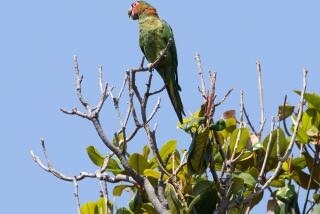Why pigeons should crow
WHAT ARE we going to do about the pigeons? Some Angelenos like to feed them in MacArthur Park or race them from their backyards. But just as many people are tired of scrapping droppings off their cars. And they’re not alone. The mayor of London has declared war on the pigeons of Trafalgar Square; Chicago has banned fanciers from keeping them as pets; the Army is working hard to evict them from its Times Square recruiting station.
Until a couple of years ago, when I began researching my book, I didn’t care one way or the other about these ubiquitous urban icons. But the more I learned about these humble birds, the more I came to admire them.
Most of us find doves endearing but look on the lowly pigeon with disdain. Well, it may come as a surprise, but pigeons are doves -- rock doves to be precise. Those beautiful white doves released at weddings? Pigeons. Noah’s dove? A pigeon. Picasso? He wasn’t drawing doves; he was painting pigeons. He even named his daughter “Paloma” -- Spanish for pigeon.
Humankind has had a fascination with the pigeon since it was first domesticated about 10,000 years ago, shortly after our other best friend, the dog. In Mesopotamia, pigeons were worshiped as fertility goddesses. The ancient Egyptians used them to ferry information about the Nile’s flood levels. Pigeons delivered the results of the first Olympics in 776 B.C., and more than 2,500 years later, they brought news to London of Napoleon’s defeat at Waterloo.
Not only did Solomon sing their praises, he used them to deliver critical messages, as did Julius Caesar, Hannibal and Genghis Khan. Ancient Rome was awash in pigeons, but the Romans didn’t seem to mind -- they took great delight in the birds.
Until the invention of the telegraph in the mid-1800s, the fastest and most reliable way to get a message anywhere was by pigeon. The famous marathon runner who brought news of Persia’s defeat to Athens took most of the day to arrive and then died. A pigeon could have delivered the message in 20 minutes.
Julius Reuters built his news-gathering empire on the wings of pigeons in the 1850s, when he used a fleet of the fowl to carry news and stock prices between Brussels and Aachen, Germany, in two hours, beating trains by six hours. Not long after, Charles Darwin proved his theory of evolution using pigeons, which populate the entire first chapter of his “Origin of Species.” (His editor prodded him to drop all that evolution nonsense and expand on the topic of pigeons. Darwin declined.)
One million pigeons served valiantly in the two world wars -- delivering critical messages, passports and other dispatches -- and were recognized for helping to save thousands of soldiers’ lives. Even today, pigeons are used by many of the world’s militaries to deliver critical messages. When communications are compromised by high-tech eavesdropping, or knocked out altogether, you can still rely on pigeons, which is exactly what Saddam Hussein supposedly did during the Persian Gulf War.
Coupled with this proud yet nearly forgotten history is the bird’s unparalleled athletic abilities. Pigeons routinely fly 600-mile races -- without stopping -- and average 60 mph. More incredibly, in these races, they’re flying home from a place they’ve never been. To put that into perspective, the very best racehorses sprint at about 40 mph around a closed track for just over a mile. Although typically thought of as a blue-collar sport, pigeon racers can count the queen of England as one of their own.
Once heralded as goddesses, war heroes and Olympians, pigeons are now best known for the damage they can do to a car’s paint job. Seems a touch unfair, don’t you think?
And contrary to pest control propaganda, pigeons carry no more diseases than humans do, and are even highly resistant to avian flu and West Nile virus. They are only as dirty as our cities, so we might consider looking in the mirror before picking on pigeons.
More to Read
Sign up for Essential California
The most important California stories and recommendations in your inbox every morning.
You may occasionally receive promotional content from the Los Angeles Times.









